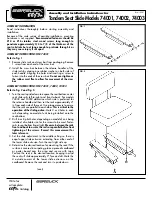
17
English
How to use a Binocular Indirect
Ophthalmoscope
by slightly loosening the ophthalmoscope knob (E) and re-
tightening when in position.
Provided the Vantage is only used by one practitioner, it will
remain in adjustment from one patient to the next.
3. Adjust the height of the light beam into the upper two thirds
of the field with the mirror angle control spindles (J).
4. Select the appropriate light patch size with the aperture
selection knob (see aperture selection, page 104).
5. Set the interpupillary distance (PD). Slide the eyepiece
control located underneath each ocular until it is positioned
directly in front of each eye. This is best done by looking at
an object, like your thumb, which has been placed in the
centre of the light patch, at approximately 40cm away while
closing each eye alternately. Each ocular incorporates a +2
diopter lens to make accommodation unnecessary. (For
further instruction on setting the PD, see page 103).
6. Select any required filters at this point (see filter selection,
page 105).
7. Method of Observation
a) It is best to have the patient reclining in order to obtain
optimum views of the periphery, although examination of
the posterior pole can be done with the patient sitting upright.
b) Turn the room lights down to enhance contrast and minimise
ambient light reflections.
c) Adjust the rheostat on the transformer so there is enough
light to see subtle colour variation on the patient’s retina.
This is usually just below half way for lightly pigmented
retinas, and slightly more for more highly pigmented retinas.








































